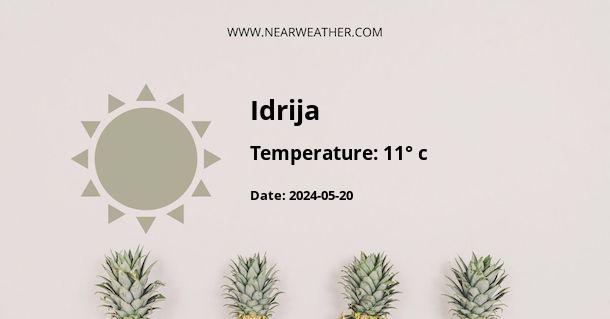Climate and Weather in Občina Idrija, Slovenia
Located in the heart of Europe, Občina Idrija is a municipality in Slovenia known for its rich history and unique geological features. Idrija's weather is characterized by a mix of a continental and Mediterranean climate due to its complex topography. Understanding its climate nuances can be critical for various activities ranging from tourism to agriculture and urban planning. Let's delve into the detailed seasonal weather patterns and climatic characteristics of this charming Slovenian locale.
General Climate Overview
The general climate of Občina Idrija can be characterized as humid continental (Köppen climate classification Dfb) with cool to warm summers and chilly winters. However, it's worth noting that the specific weather conditions can be heavily influenced by the Adriatic Sea to the southwest, and the Alpine climate to the north.
Seasonal Weather Patterns
-
Spring (March - May):
The spring season in Idrija sees a gradual rise in temperatures with frequent rain showers. The average temperature ranges from 5°C to 15°C (41°F to 59°F). Precipitation is common, with April often being the wettest month of spring.
-
Summer (June - August):
Summer months are usually the warmest with temperatures averaging between 15°C and 25°C (59°F to 77°F). Thunderstorms are prevalent, due to the combination of heat and humidity, and contribute to July typically being the wettest month of the year.
-
Fall (September - November):
Autumn brings cooler temperatures and a higher likelihood of fog, especially in the valleys. Average temperatures fall between 10°C and 20°C (50°F to 68°F). Rainfall continues to be abundant, and the weather gradually turns colder towards the end of November.
-
Winter (December - February):
During winter, Idrija experiences cold conditions with average temperatures hovering around 0°C (32°F), although they can drop significantly below freezing, especially at night. Snowfall is common, and the region is blanketed in snow several times throughout the season.
Temperature and Precipitation Tables
Monthly Average Temperatures (°C/°F)
| Month | High / Low (°C) | High / Low (°F) |
|---|---|---|
| January | 1 / -5 | 34 / 23 |
| February | 3 / -3 | 37 / 27 |
| March | 8 / 0 | 46 / 32 |
| April | 13 / 4 | 55 / 39 |
| May | 18 / 9 | 64 / 48 |
| June | 21 / 12 | 70 / 54 |
| July | 24 / 14 | 75 / 57 |
| August | 23 / 14 | 73 / 57 |
| September | 19 / 11 | 66 / 52 |
| October | 14 / 6 | 57 / 43 |
| November | 8 / 2 | 46 / 36 |
| December | 3 / -2 | 37 / 28 |
Monthly Average Precipitation (mm/in)
| Month | Precipitation (mm) | Precipitation (in) |
|---|---|---|
| January | 70 | 2.76 |
| February | 65 | 2.56 |
| March | 80 | 3.15 |
| April | 110 | 4.33 |
| May | 120 | 4.72 |
| June | 140 | 5.51 |
| July | 150 | 5.91 |
| August | 140 | 5.51 |
| September | 140 | 5.51 |
| October | 130 | 5.12 |
| November | 120 | 4.72 |
| December | 100 | 3.94 |
Weather Extremes and Records
While Idrija's climate is fairly consistent with the patterns described, it is not immune to extreme weather events which include heatwaves and cold spells. Record high temperatures can approach 35°C (95°F) during heatwaves in summer, while the coldest nights in winter may see lows plummet to below -20°C (-4°F).
Wind, Humidity, and Other Climatic Factors
Wind speed in Idrija is generally light to moderate, with occasional stronger gusts associated with passing weather fronts. The region's complex terrain can lead to localized wind patterns and microclimates. Humidity levels in Idrija are typically high due to the surrounding vegetation and the proximity to the Adriatic Sea. Fog is common in the valleys, particularly during autumn and winter months.
"The municipality's microclimates make the region an interesting case study for climatologists and meteorologists," emphasizes Dr. Matej Ogrin, a Slovenian geographer known for his work on local climate dynamics.
Climate Change Considerations
With the global climate undergoing significant changes, Idrija, like many other parts of the world, is experiencing shifts in its weather patterns. These include an increase in the number of extreme weather events, changes in precipitation patterns, and a trend toward warmer temperatures. This can have implications for the local ecology, water resources, and the frequency and intensity of natural hazards such as floods and landslides.
Adaptations and Predictions for the Future
In response to the changing climate, local authorities and residents are adapting through enhanced land management practices, disaster preparedness, and sustainable resource use. The future will undoubtedly require a proactive approach to climate resilience, considering that the predictions indicate more extreme weather occurrences and greater variability.
Supporting Tourism and Outdoor Activities
The varied climate of Idrija is a significant asset for tourism and offers a range of seasonal activities. Winter sports enthusiasts can enjoy skiing and snowboarding when conditions permit, while summer offers perfect opportunities for hiking, cycling, and exploring the natural beauty of the area.
Conclusion
In summary, the climate and weather in Občina Idrija, Slovenia, exhibit characteristics of both continental and Mediterranean influences, resulting in distinct seasons with a wide range of weather patterns. Understanding these nuances is vital for locals, tourists, and planners alike. Future challenges posed by climate change will require continued monitoring and adaptive strategies to protect and leverage the region's climatic diversity.
A - Idrija's Latitude is 46.000000 & Longitude is 14.000000.
A - Weather in Idrija is 1° today.
A - Climate Conditions in Idrija shows light snow today.
A - Humidity in Idrija is 96% today.
A - Wind speed in Idrija is 14.47 km/h, flowing at 94° wind direction. today.
